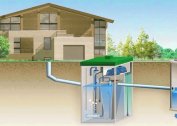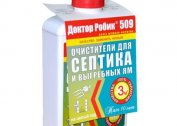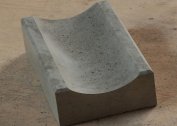Domestic and industrial wastewater may contain hazardous pollutants. Discharge of draining fluids should be carried out under tight supervision. Control is carried out by both authorities and organizations involved in water disposal.
Norms and Prohibitions for Discharged Wastewater
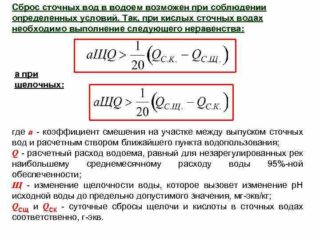 In accordance with the Federal Law "On Environmental Protection", "On Water Supply and Sanitation" and the Water Code, it is forbidden to discharge sewage into natural water bodies:
In accordance with the Federal Law "On Environmental Protection", "On Water Supply and Sanitation" and the Water Code, it is forbidden to discharge sewage into natural water bodies:
- containing impurities for which standards for acceptable content have not been developed;
- suitable for secondary use, for example, in reverse water supply;
- posing a risk of exceeding the epidemiological threshold;
- which are the final products of the neutralization of industrial and household waste;
- Forming explosive mixtures, toxic gases, as well as harmful impurities that impede bio-treatment.
- containing components containing oil and construction waste.
In the effluents allowed for discharge, the maximum permissible concentration of impurities (MPC) must be taken into account. According to GOST - no more than 500 mg / l of suspensions and pop-up substances. The temperature is not higher than 40 degrees, and a pH of 6.5–9.
It is also necessary to consider volley discharge discharges. This concept means the release of sewage into the treatment plant from all plumbing devices at the same time. So that the liquid filled with contaminants does not get into the sewers or, worse, into the reservoir, it is important to correctly calculate the volume of VOCs.
Volley discharges are divided into emergency and forced discharges due to poor pipe passage. All of them violate the rules of water disposal, because due to the impossibility of controlling MPC and the speed of wastewater, they can pollute not only the reservoir itself, but also the area adjacent to it.
Discharge control
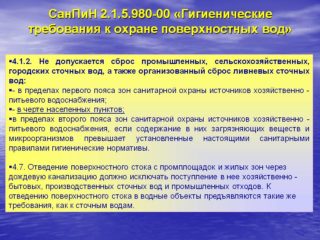 The state strictly regulates the norms for the discharge of pollutants into the sewer. The quality control of domestic and industrial wastewater is carried out by executive and local governing bodies, companies and private water drainage companies. They coordinate their actions with Rosprirodnadzor and Rosrybolovstvo.
The state strictly regulates the norms for the discharge of pollutants into the sewer. The quality control of domestic and industrial wastewater is carried out by executive and local governing bodies, companies and private water drainage companies. They coordinate their actions with Rosprirodnadzor and Rosrybolovstvo.
The main document containing the rules for wastewater discharge is SanPiN 2.1.5.980-00. According to him, before the discharge, the composition is checked for the content of contaminants and the presence of pathogenic bacteria. Reconciliation is carried out with the indicators of the declaration that each enterprise provides for hazardous substances in wastewater.
Conducting planned activities for sampling and laboratory research is carried out no more than once during three months, but at least once a year. Sometimes unplanned checks are carried out upon detection of:
- violations during discharge, including without the use of treatment systems;
- inconsistencies with the data entered in the declaration on the composition and content, as well as the identification of prohibited impurities;
- problems not fixed by order.
Inspections are carried out on the fact of emergency situations, the occurrence of infections and poisoning.
Obtaining permission to discharge effluents
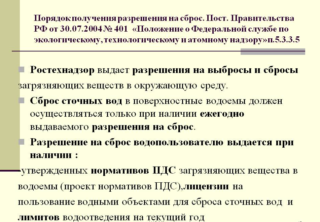 For recently launched organizations, the rationale for obtaining permission to divert wastewater to the central sewer is approval by Vodokanal, and for the enterprises that have undergone reconstruction, a water management passport.
For recently launched organizations, the rationale for obtaining permission to divert wastewater to the central sewer is approval by Vodokanal, and for the enterprises that have undergone reconstruction, a water management passport.
Sanctions on the discharge of sewage into natural water bodies are issued with the consent of the authorities for the protection of natural resources and environmental protection.
In order to obtain permission for the release of wastewater from the relevant organizations, you must provide:
- Documents that confirm the work performed on the installation of sewage pipes, wells for a drain, insulation, foundation foundation, soil compaction.
- Technical passports for equipment and materials.
- A certificate that confirms the application of a corrosion-resistant coating on welds and joints, as well as their diagnosis.
- Information indicating deviations from the original design of the structure.
- Performance certificates for the external and external sewage system.
- The certificate on assignment to the object of the address and number in the register.
In addition, the design drawings of the drainage line, dilution of the sewer pipeline and sanitary equipment are attached.
Relief relief pattern
According to the laws of the Russian Federation, the discharge of clarified effluents from the sewer onto the terrain and burial in the ground is not allowed. This is allowed only in rare cases, when the liquid is pre-cleaned up to 95 percent. In this case, permission is required with the provision of a disinfection document. The location of the release is agreed with local authorities and Rospotrebnadzor.
Water discharge pattern
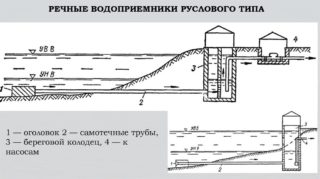 The draft justification of the place of discharge into the lake, river or sea allows us to determine the possibility of such an action and is a technical report that includes such stages:
The draft justification of the place of discharge into the lake, river or sea allows us to determine the possibility of such an action and is a technical report that includes such stages:
- checking the distance from treatment facilities to the reservoir and the economic component of laying the pipeline;
- obtaining an extract from the water registry, based on which information is generated on the state of the water body and the actual purpose of its use;
- hydrological characterization;
- study of the state of the shore and basin for the construction of a water outlet;
- obtaining fishery characteristics;
- establishment of a nearby sanitary zone and source of drinking water supply;
- analysis of the likely environmental impact.
Coordination of the discharge point is necessary when creating a project and erecting septic tanks, treatment plants with filtration fields and other VOCs, stormwater and industrial wastewater. It is one of the necessary steps in obtaining permission to discharge clarified liquid into a water body. The time for approval is no more than three months from the date of providing all the necessary documentation.
It is necessary to obtain permission, sampling to control the quality of water, as well as discharged volumes. The requirements that are presented depend directly on the reservoir itself and its application.
Any discharge on the territory of household water supply facilities, as well as water protection zones, is prohibited.
Varieties of effluent release
To discharge the wastewater that has been treated into water bodies, coastal, channel and deep releases are used. The former are divided into two categories: unfilled and flooded. The latter are wells installed on the shore with the discharge of sewage water under the level of a river or lake. Non-flooded combine flows at a certain angle. Depth releases provide high volume discharge. They allow you to move the ejection point away from the coast.
Channel outlets, as a rule, are located at a certain distance from the coastal zone. They are of three types:
- Concentrated outlets are needed to dilute the main water runoff using the pressure method or to supply liquid to a certain point where the level of pollution will be acceptable.
- Dissipators are placed on a horizontal section of the pipe line, along the entire length of which several heads are placed or slots are made. With their help, effluents are poured into rivers.
- Ejector equipped with nozzles of different sizes. Due to this, it is possible to efficiently drain liquids in water bodies with different flows.
A suitable structure is chosen depending on sanitary standards, the need to dilute wastewater, a “mirror” of a well and a water body.
The standards for wastewater treatment must be observed not only because of a possible fine, which is provided for in Article 8.14 of the Administrative Code. On the conscience of the offender will be the death of aquatic inhabitants and harm to human health.
